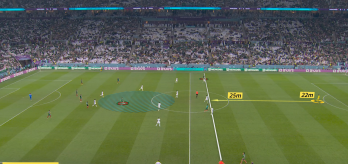An investigation by FIFA's Football Analysis and Insights Team found that overall, goalkeepers were playing on average 1.3m "higher" (i.e., further away from their own goal line) and 1.0m closer to their defensive line at the FIFA World Cup Qatar 2022™ than they were at the FIFA World Cup Russia 2018™. The data also demonstrated that this was a consistent trend among goalkeepers at the 2022 tournament, with very few strong outliers.
For the purpose of the analysis of the goalkeeper's positions in this article, only events from open play are used, with positions during set plays excluded.
GOALKEEPER PROFILE
This data can be broken down to create a "profile" for each goalkeeper, which plots their position relative to their own goal line and to their defence. This breakdown shows that a distinctive shift in the profile of the goalkeeper's position occurred in 2022. In 2018, 21 goalkeepers fitted the profile of playing both "low" (i.e., close to their goal line) and far behind their defensive line. In 2022, just seven goalkeepers fitted this profile. Moreover, in 2022, 20 goalkeepers fitted the profile of playing high up the pitch and close to their defensive line, compared to just eight in 2018.
FIFA Senior Football and Goalkeeping Expert Pascal Zuberbühler believes this data provides important information for coaches and defenders.
"It is extremely important for players in the defensive line and coaches to know where the goalkeeper will be in different moments of the game. There is no absolute right position, but it is crucial for the coach and defenders to know where they can expect their goalkeeper to be. For example, when the defensive line is holding ten metres inside their own half; when they are on the half-way line; or if they are pushed ten metres inside the opposition half. The positioning in such moments of the game must be worked on, on the training pitch and everyone should know where the goalkeeper will be," he explained.
GOALKEEPERS' POSITIONING
The goalkeeper's connection with the defensive line is a continuously changing entity within any individual game. So, how did goalkeepers adjust their positioning depending on the score, or in relation to whether and where their team had possession?
Positioning when winning
Our data team produced some interesting findings in this area. They showed that, in 2022, the distance between the goalkeeper and the defensive line when their team was winning decreased by an average of 1.5m compared to 2018. This change was consistently demonstrated across the tournament.
Croatia's Dominik Livaković was the goalkeeper who remained furthest from his defensive line when his team was winning, positioning himself just below the average distance away from his goal.
Jordan Pickford (ENG) and Vanja Milinković-Savić (SRB) positioned themselves closest to their defensive lines, and stood furthest away from their own goal lines when their team was winning.
Positioning when the goalkeeper's team was in possession in the final third
When their teams were in possession in the final third, the data shows that goalkeepers moved 3.6m higher up the pitch than they did in similar situations in 2018. This a sizeable shift, and it can be seen consistently among the majority of the goalkeepers who competed at FIFA World Cup Qatar 2022.
According to Zuberbühler, "This demonstrates that goalkeepers are much more comfortable at this height than on the edge of their penalty area, when their team has the ball in the final third. This is part of the evolution of the modern goalkeeper and comes from training with the team."
Unai Simón (ESP), Mathew Ryan (AUS) and Manuel Neuer (GER) were the "highest" goalkeepers when their teams had possession in the final third, while Alireza Beiranvand (IRN), Keylor Navas (CRC) and Aymen Dahmen (TUN) remained closer to their goal line in this game state.
Goalkeepers' positioning when their teams were losing
The data from 2022 also shows that goalkeepers played 1.4m higher when their team was losing compared to 2018. In Qatar, no goalkeeper averaged a position as deep as the lowest average line height in Russia.
When their teams were losing, the average height of the goalkeeper's position was 14.2m, (compared to 12.8m in 2018). At the same time, there was a small shift in the average distance between goalkeepers and defensive lines when their teams were losing: this was 20.4m in 2022, compared to 20.1m in 2018.
DECISION-MAKING
The best goalkeepers in the world are brilliant decision-makers. To make a key intervention goalkeepers have to consider the following questions:
- Is there a defender between the goalkeeper and the attacking player with the ball?
- Can the defender use their body to create an opportunity for the goalkeeper to become an extra player and make an intervention?
These scenarios must be coached and practised, with defenders and goalkeepers working together to create understanding and expectations.
As demonstrated in the clips below, Serbia goalkeeper Vanja Milinković-Savić (23) decides to stay close to his goal line when he has defenders between him and the Switzerland players in possession. As soon as Switzerland's Breel Embolo (7) breaches his defensive line, he makes a quick decision to advance, making his body as big as possible, narrowing the angle available to Embolo, and blocking the attempt at goal.
Similarly, England goalkeeper Jordan Pickford (1) adopts a good starting position 8m from his goal line. When his defensive line is breached, he makes the decision to hold his position and defend the goal in the 1v1 situation. He sets himself well and makes an x-block, saving with his left hand.
Another example of quick decision-making occurred in Switzerland's game against Cameroon, when Switzerland goalkeeper Yann Sommer (1) opted to retreat closer to his goal despite a 1v1 situation developing early. He correctly judged that his defenders were recovering and chose to defend his goal. He held his position and made a very good save.
Goalkeepers' positioning: The four semi-finalists
While different goalkeepers displayed different preferences in relation to their positioning, goalkeepers who are brilliant in dangerous situations have certain things in common.
Pascal Zuberbühler has identified some critical moments of outstanding goalkeeping from the four semi-finalists.
Emiliano Martínez (ARG)
Speed of decision-making in highly pressurised situations separates the best goalkeepers in the world from the rest.
At the end of extra time in the World Cup final, the scores were tied at 3-3 in the third minute of injury time, and penalties were beckoning. It was at that moment that Argentina goalkeeper Emiliano Martínez made what Zuberbühler considers "the save of the century."
The importance of the moment and the significance of this save cannot be underestimated. With Martínez positioned 7m from his goal line and 20m from his defensive line, Argentina defender, Nicolás Otamendi (19), missed an attempted clearance, allowing Randal Kolo Muani (12) to break into the penalty area. Martínez advanced at speed, and showed huge courage and strength to stand tall and wait before making a stunning and crucial save.
Another example of his brilliant decision-making at a big moment came in the seventh minute of additional time in Argentina's last 16 match against Australia, when his team were winning 2-1. In practically the last move of the game, Australia's Garang Kuol (21) capitalised on several defensive errors to get free. Martínez reacted very quickly, taking hugely impactful first steps and making a significant save in the x-block position.
Hugo Lloris (FRA)
France goalkeeper Hugo Lloris had a preference for starting from deeper positions, and in his side's quarter-final match against England he displayed some outstanding decision-making.
In the first clip here, he starts just 1m from his goal line and 11m from his defensive line when Bukayo Saka (17) plays the ball into the French penalty area. As soon as Harry Kane (9) receives in behind France defender Dayot Upamecano (18), Lloris, in a good starting position, recognises he is in a 1v1 situation and advances explosively towards Kane to block the shot.
In the next clip, taken from France's match against Poland, Lloris recognises he is too far away (23m) from the ball when France's defensive line is breached, and he retreats to his near post. He recognises that his defender is recovering. Upamecano (18) uses his body to close the opposite side of the goal, meaning that the attacker can only attack the near post, which Lloris has covered.
Dominik Livaković (CRO)
Croatia goalkeeper Dominik Livaković generally preferred to start in a deeper position than Lloris, but he was equally effective in his decision-making.
In the first example, taken from the match against Belgium, he starts just 2m from his goal line and 21m from his defensive line. As the ball is played through by Kevin De Bruyne (7), Livaković recognises that he has three defenders against Belgium's two attackers. With Belgium's Yannick Carrasco (11) under pressure from his defender, he holds his position and waits until the opportunity to block emerges.
In the second clip, Livaković is again positioned very close to his own goal line when the ball is crossed into the penalty area. His defender fails in his attempted clearance and the ball breaks to a free attacker at his far post. Livaković immediately recognises that Morocco's Youssef En Nesyri (19) has controlled the ball, and he reacts with a quick decision to advance and narrow the angle for the attempt at goal, before saving with his outstretched right hand.
Yassine Bounou (MAR)
In his first clip, Morocco goalkeeper Yassine Bounou is positioned 11m from his goal when the first key decision-making moment occurs. When the ball is played forward, he can see he still has a defender who can intervene in the situation, so he retreats and moves in relation to the ball. As soon as his defender is beaten 1v1, he immediately decides to defend the goal, sets himself and makes himself big before going on to save the attempt.
In the second clip, when the ball is played forward, Bounou is 12m from his own goal line and 18m from his defensive line. He immediately recognises that the striker is ahead of his defender, and takes the risk to defend the space, timing his move perfectly to make the intervention. As the move progresses, he retreats and sets himself perfectly at his near post, aware of the run from the incoming attacker. He makes a quick decision to assume the x-block position, and makes a vital save.
Summary
- Goalkeepers at the FIFA World Cup 2022 Qatar™ were positioned an average of 1.3m higher up the pitch than those at the 2018 World Cup, and 1.0m closer to their defensive lines.
- In addition, the dominant positional profile for goalkeepers at the 2022 tournament was to play high and close to their defensive line, whereas in 2018 the dominant profile was to play low (close to their goal line) and far from their defensive line.
- When their teams were winning, the distance between goalkeepers and their defensive lines decreased by an average of 1.5m as compared to teams in the same situation in 2018. By contrast, when their teams were in possession and in the final third, the goalkeepers moved 3.8m further up the pitch than they did in Russia in 2018, and when their teams were losing, the height of the average goalkeeper position was 14.2m compared to 12.8m in 2018, an increase of 1.4m.
- Effective decision-making is crucial for the modern goalkeeper, particularly when assessing whether to defend a zone or defend the goal. The relationship between the goalkeeper, the defenders and the attacker with the ball is fundamental in big moments in games. Developing this relationship requires active coaching and training as a collective defensive unit.

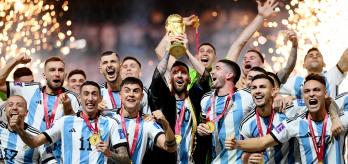




.variant64x64.png)

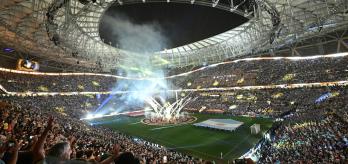
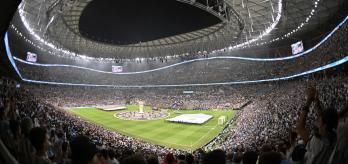
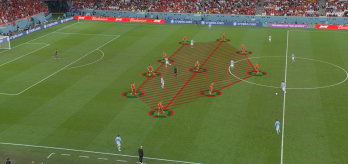
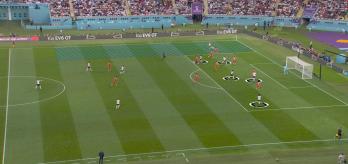
.variant348x164.png)
